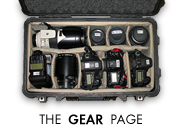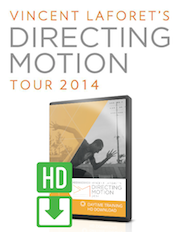Preparing for the Biggest Organized Event of Them All: The Olympics
I’m not sure there’s an event I ever cover that requires as muchadvance logistics planning as the Olympics. Travel plans start up to ayear before The Games, and from there on you continue to prepare untilthe games begin. In this post, I will discuss how I did my best toprepare for these games in advance, and how I packed all of myequipment for the Olympics—something that took well over a month on itsown in the end. (You can find a gallery of how I packed my equipment,and a detailed explanations of each step here.)
First of all, you’ve got to understand that every Olympics is different. It’srun by a different host committee every two years, and the rulesnaturally tend to change with each Olympics. So most of the stress ofgetting ready comes from never being quite sure what you will—or willnot be—allowed to do: how many—if any—remote cameras you’ll be allowedto use and where you’ll be permitted to put them. (Not to mention whatthe venues will look like, what the lighting and background will be,and where you’ll be able to shoot from—all pretty key unknowns untilyou arrive.)
In the past – all of the Olympics have had “PhotoVenue Managers” these are volunteers who are in the photo business—andusually have many Olympics under their belts. They know who you are—youknow who they are and how to get in touch with them in advance—and youcan make special requests months in advance and work out any potentialconcerns that might arise. Basically they’re there to make sureeverything goes smoothly (no one trips on a camera or photographer onlive TV) and just as importantly to help you get the best imagespossible.
This Olympics, these veterans haven’t been invitedback. A group of local photo managers will be assigned to each venue.And truth be told—that’s nerve wrecking for all photographers headinginto Beijing—we have no idea what to expect. The rule book can bere-written, and there likely isn’t much we’ll be able to do about it. Ido hope we’ll get along just fine with the local Photo Venue Managers,even though most of them are said to be young adults detached from the“security” team with no prior photo experience. Add to that anylanguage barriers, and the fact that no advance planning waspossible—well… it could be rough (not sounding too good is it?) Soneedless to say, the stress level, and uncertainty of how successful ofan Olympics this will be is at an all time high.
Don’t forgetthat on top of all of this uncertainty. We still have to worry aboutthe following at each event we cover: We don’t know who will win/loseor become the news, where that will happen, when that will happen, orfrom where we can get the best picture from, or with what lens andexposure (nor when we can put our guard down or take a meal/bathroombreak) …. you never know this until the event happens—live—and inphotography there are no second chances; you are either the “hero orthe zero” with little in between. This is why photographers, who bynature are used to capturing what is a sometimes chaotic series ofevents, like to have at least the basics figured out before they get to the venue, so that they only have to worry about making “the” picture.
This is part of the Olympics the readers never see (and hopefully what these blogs will help reveal)—and while it’s frankly not their problem, it’sours, in a big way. What we have to do on our end, is to plan on doingbusiness as usual, and come prepared with all of the necessary gear(even though we may not be able to use much of it!) and we’ll need tostay on our best behaviors and stay patient, no matter how bad thingsmay initially present themselves…
Another new development withthese Olympics: You have to decide what it is that you’re going tobring far ahead of time, because the Chinese government is requiring usto get an “Equipment Confirmation Letter” to bring gear into and out ofChina (I guess they’re afraid we’ll sell it??? Normally an Olympiccredential is sufficient for any host country) It’s quite strange, asno Olympics that I’ve covered prior to this has required such a form(although it’s always best to get a list (or Carnet) of anyprofessional equipment you’re carrying in and out of a foreign countrystamped by your local customs) but it was necessary this time, and itrequired a visit to the Chinese Embassy… just one more thing to do.It makes it more difficult because you can’t decide last minute tobring an extra lens or camera… once the list is stamped by theChinese Embassy, you’re done.
One of the biggest challenge for aphotographer is knowing what to bring. If we were covering just onesport, it would be easy. Most photographers could probably bring 2-3cameras, and 2-3 lenses, max. But given that we’ll have a few dozensports to chose from, and that the equipment needed to cover each sportcan vary widely, it’s a challenge to say the least. And don’t forget:we have to carry everything, so the more you bring, the more you breakyour back. I am easily bringing more than 200 lbs of equipment with me.
One common trick photographers use to make “exceptional” images is the use of remote cameras. There are many fantastic angles that you cannot physically shoot from; however if you mount a remote camera there ahead of time, with a bit of luck you’ll get an amazing image. This of course requires us to bring extra cameras, lenses, radio triggers and mounting equipment, doubling the amount of gear we bring. But the pictures are almost always worth the effort. One key thing to realize: remote cameras have to be mounted far ahead of an event. Sometimes you have to leave a remote in a catwalk for the entire duration of an event (up to a week) because you won’t have access to it during the event (for security and safety purposes.) That means you have to make intelligent decisions on how you use that gear and where you put it. For the men’s 100m final in Athens, I showed up at 5 a.m. to put up remotes—for a race that didn’t start until after 10 p.m. that evening—and the race lasted less than 10 seconds…. Hopefully you now have a better idea of all of the work and time that goes into “getting the picture.” Multiply that by 2 weeks and you realize that covering The Games is a LOT of work—and requires a lot of advance planning.
What I’ve gone ahead and done is to create a separate web gallery that shows each step of the packing process for those that are interested. You’ll get an idea of what type of equipment I’m bringing and how I pack it. Writing it out in this post would make it a bit too long, so I think the gallery is the best way to go.
The next step will be to unpack everything once I arrive and to make the decision each evening (prior to the next day’s events) as to what I’ll need to bring with me to best pull off an image. The Games are challenging, exhausting and mentally trying. But it’s the “Olympics” for photographers if you will—part of “our” games—where you bring the world’s best photographers into one place and have a competition to see who can come back with the best images…. but a photographer must always keep the following in mind: it’s a marathon—not a sprint!
More to come in the upcoming days.
















Good luck Vincent. Patrick.
Wow, nice lenses:-D Good luck!:-D
Very interesting to see how pro photog prepares for major sports event!
Hey Vincent!
Very cool indeed! Great to see a whole other side of photography from what I experience!
Thanks!
Moose Peterson
Great post Vincent, thanks for that. Best of luck at the games.
wow! now i know where they shot the ad for the canon ad with all of the lenses 🙂
*drool*
I hope you get to enjoy the Games and not work too hard. Looking forward to hearing more and seeing some of your photographs.
looking forward to seeing your images from China. Best of luck getting through Customs!
Very interesting. I enjoyed reading and looking through the gallery. Looking forward to the images. We’re pulling for you. 🙂
Wow. Look at all those lenses! I hope you get to use them all. Have fun!
Thanks for putting the time into an interesting article. Hope everything goes well for you out there too.
One question – when you mention setting up the remote cameras sometimes a week in advance, how do you manage battery life for that particular remote? Hook it up to the mains, or do they allow access briefly to switch it on closer to the event?
Hi Vincent, just wondering, you mentioned the fact that you can’t take it all, but still you take a 400/2.8 and 500/4, wouldn’t the 400 with a 1.4 TC just as good (or close at least), and save a little of your back?
Best regards, and good luck in the Olympics!
I would reckon the images made by you that stand out the most will be with your T/S lenses 😉
Jan
Very interesting blog post. Good lcuk over there in Bejing!!
This is so cool, I can’t wait to see what else you have to show us. Keep it up!
Wow, Vincent… fascinating. Thanks for taking the time to share this!
OK I just gotta ask. Where on earth did you find the Canon N-Rain covers?
the 500mm with a 2x – that’s crazy talk! 🙂
Thanks so much for showing how it’s done. It’s great to see how an experienced Olympic shooter pulls a logistical nightmare together. Looking forward to seeing the results of all your hard work.
Mikes back is going to hurt after this!
Thanks for sharing this! It is a great insight to know the background of the craft. I’m sure some people just think a photographer whips out a camera and takes a picture. Volia! But it is much more involved, especially in this case. Thanks again for sharing.
thats just insane! its a canon advertisement!
Thanks for sharing Vincent – most informative. I hope you’re getting some killer shots in Beijing.
Holy optics, Batman! That’s some beast equipment you’ve got there. Can’t wait to see the images you get.
Wow, that is amazing! Thanks for sharing, I will share parts of it with my high school photography class.
Why is it that all the pictures shown in the article were taken with a Nikon camera, was a canon not good enough ?
Hard to prepare – easily in battle 😉
Nice equipment. Loading camera and computer equipment is always a big job to do.
Эх… 🙂 Вы бы знали что про Вас пишут в других блогах 🙂
Автору памятник нужно поставить за такое!:)
Что то Автор почти совсем перестал писать посты и даже админить блог? Может что случилось?
хотела желание с вами поообщаться поближе, теснить пара вопросов сообразно оформлению и обмену блогами, дозволительно также посотрудничать
списки кандидатов, выдвигаемые партиями политическими и избирательными объединениями (блоками) для выборах в представительные органы, проводимые по пропорциональной избирательной системе.
Ну вы подеритесь еще, тоже мне спорщики 🙂
Прикольно было почитать 🙂 Попробуем-с тоже ответить в ближайших постах.
Hey Vincent.
I know your busy, but I am hoping for some help.
As a newborn / wedding – my wife and I shoot well over 2tb of data every year. We currently use Adobe LR and up until now we have just bought the affordable two bay harddrives (WD & iomega) and set them in a Raid 5 Configuration.
Needless to say we are starting to run out of room on our desk and office and we now have a whole library of Drives registered in Adobe LR.
We routinely work on weddings and their albums for up to a year, with extra orders so we have to keep all drive connected.
We dont have the funds available to get an xserve but do you know of a company that makes a system that can handle loads of data – or would you suggest a new work flow. .
Thanks, I know your busy.
Chris
В мой блог вчера прислали образец креативности:
Hi
I’m surprise you put all your remote in the same case.
Hope this one was not lost 🙂